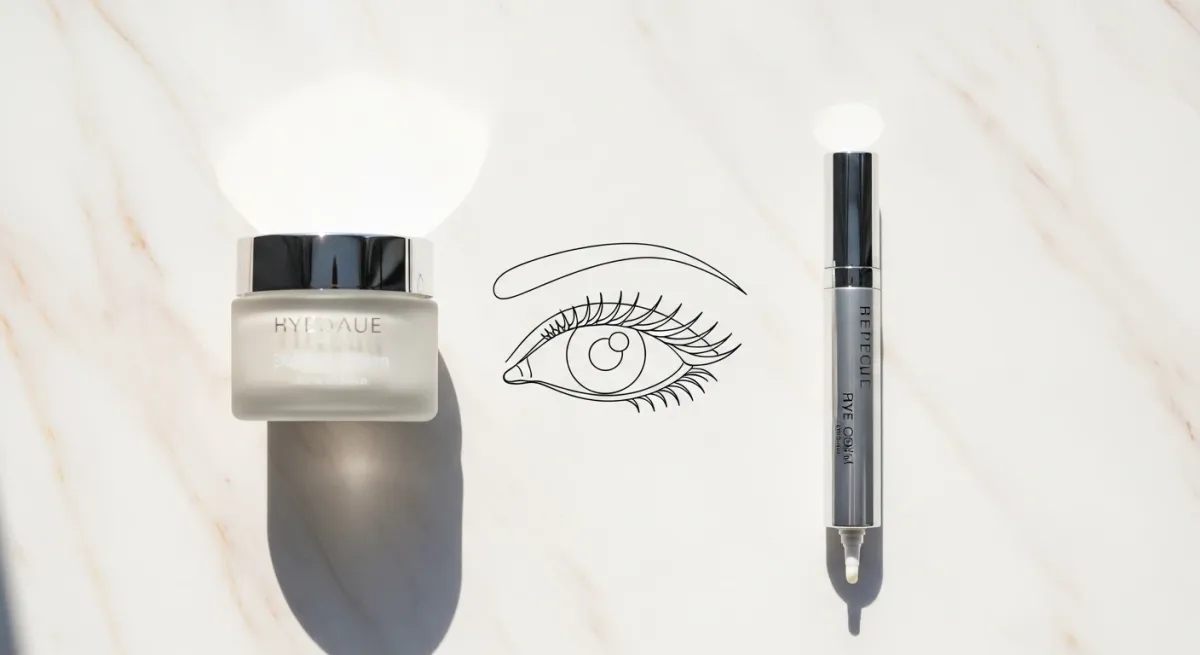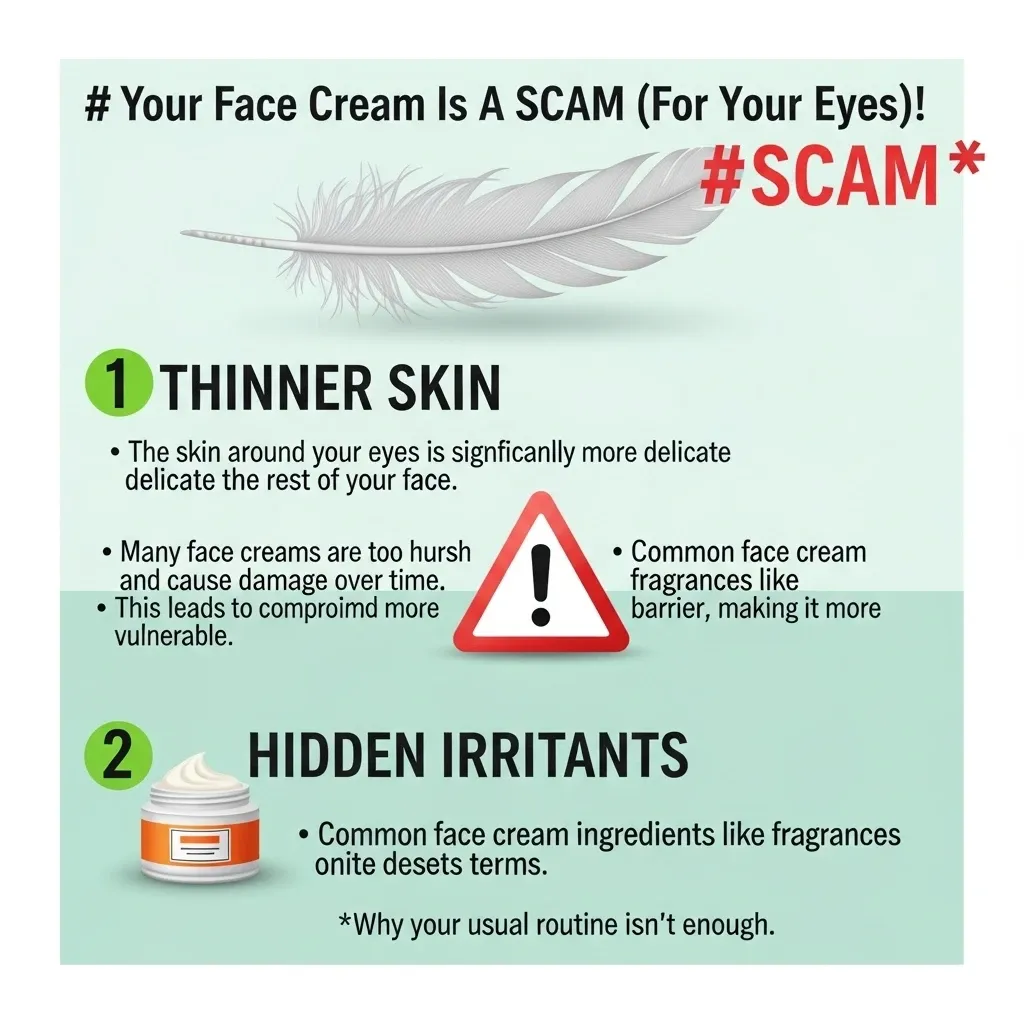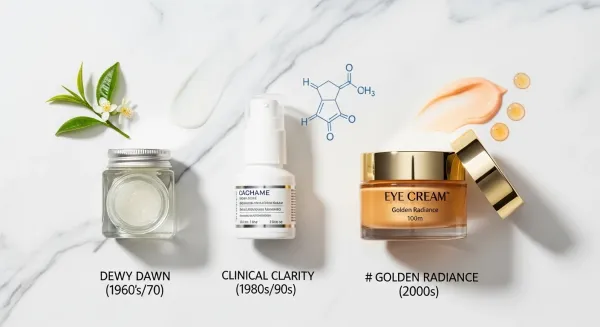The Truth About Eye Cream vs. Face Cream Around Eyes: what actually matters (and what doesn’t)
The truth about eye cream vs. face cream around eyes: what works, how to choose, and simple tips for brighter, smoother under-eyes.

The Truth About Eye Cream vs. Face Cream Around Eyes comes down to one thing: the skin under your eyes plays by different rules, but you don’t need a 27-step routine to win. If you want brighter, smoother, less puffy eyes—without irritation or wasted spend—this guide is your playbook.

111SKIN Women's Black Diamond Eye Cream, Multicolored
- What it is: Formulated to address concerns related to the delicate skin around your eye, this 111SKIN cream will be a new staple of your beauty regimen
- Good to know: Paraben free, phthalate free, gluten free, mineral oil free
- What it does: Helps firm, sculpt, and reduce the appearance of fine lines. Combats sagging and drooping skin. Helps brighten the appearance of dark circles
- Key ingredients: Nac Y2, Granactive Retinoid, Fine Black Diamond Powder
- How to use: Gently pat a half pump of serum onto skin, then gently work in until fully absorbed
TL;DR (read this if you’re busy)
- Yes, eye creams are different from face creams—mainly in texture, migration control, and how they handle irritants near your eyeballs.
- Can you use face cream around eyes? Sometimes—but only if it passes a quick 5-point “Eye-Safe” Litmus Test below.
- If you have dark circles, puffiness, or lines, a targeted eye formula usually outperforms a basic face moisturizer.
- Most results come from ingredients + consistency, not fancy jars.
- Keep this post as a decision tool—not a medical claim. For safety around eyes, see the FDA’s guidance on eye cosmetic safety and the AAD’s smart buying tips.
Why the eye area is a different game (without the jargon)
What makes eye skin… eye skin?

- Thinner & drier: Fewer oil glands = dries out faster.
- Always moving: You blink, smile, squint—thousands of micro-movements a day.
- Closer to the eyeball: If a product “runs,” it can sting and water.
That’s why many eye products are designed to stay put, avoid common irritants, and use gentler versions of actives near the lash line.
See also Harvard Health’s clear take on when a separate eye cream helps: Do you need a separate eye cream?
Eye cream vs. face cream: the head-to-head
Use this table to see how they’re usually built:
| Feature | Eye Cream (Specialized) | Face Cream (General) |
|---|---|---|
| Ingredient strength | Gentler levels near eyes; low-migration textures | Often stronger acids/retinoids suited to cheeks/forehead |
| Targeted concerns | Puffiness (caffeine), dark circles (pigment/vascular support), fine lines (peptides) | Hydration, anti-aging or acne for the whole face |
| Texture & migration | Designed not to creep into eyes | Can spread or run with heat/sweat |
| Irritants avoided | Often fragrance-free and essential-oil-free | Fragrance is common; can irritate near eyes |
| Testing | Often ophthalmologist-tested | Typically dermatologist-tested for general use |
Bottom line: targeting + tolerability is the difference. The eye zone needs both.
The 5-Point “Eye-Safe” Litmus Test for your face moisturizer
Grab your current face cream and score it. If it fails any of these, keep it off the eye area.
- Fragrance check: Any “Fragrance/Parfum” or essential oils (citrus, lavender, mint)? Fail.
- Strong actives: Medium/high levels of glycolic, pure L-ascorbic acid at high %, high-dose retinoids, or salicylic acid? Fail.
- Ophthalmologist-tested: Does the brand explicitly say this? If not, proceed with caution.
- Heavy occlusives up top: Petrolatum/mineral oil high on the list? Can trap keratin and create milia on some people. Risky.
- Migration test: Dot on the back of your hand. After 60 seconds of warmth, does it slide? If yes, not for eyelids.
If it passes all five: you might use a thin layer along the orbital bone (not the lash line). But if you want targeted benefits like de-puffing or brightening, a purpose-built eye formula still wins.

“Do I actually need an eye cream?” Use this decision tree.
Start here:
- I see puffiness in the morning.
Choose an eye cream with caffeine and a stay-put gel/cream. Want the full playbook on caffeine and timing? Read Caffeine Eye Creams: Do They Actually Work? - I’ve got dark circles.
First, identify the type (shadowing, pigment, or vascular). Then go targeted. This practical walkthrough helps: 7 Essential Steps to Banish Dark Circles - Fine lines are creeping in.
Consider gentle eye-safe retinoids/retinal or peptide blends. If you’re curious about using retinoids near eyes, here’s a safe, step-by-step guide: Retinol for Eyes—Use It Safely - I’ve tried creams and I’m still stuck.
Eyes age from multiple angles (sleep, salt, screen time, muscle movement). This piece shows what to add beyond cream: Eye Wrinkles That Go Way Beyond Eye Cream - New to eye care and don’t want to waste money.
Start with fundamentals, ingredients that actually move the needle, and a tight order of operations: The Eye Care Guide—Stop Wasting Money
The money talk: is eye cream “just a tiny, pricey moisturizer”?
Let’s do the math.
- Typical eye cream size: 15 ml
- Use: ~0.25 ml (pea-size) for both eyes, 2× daily
- Days per tube: 15 ml ÷ (0.5 ml/day) ≈ 30 days (conservative)
With lighter application, many stretch 90–120 days.
Cost per day examples:
- €40 eye cream over 90 days → €0.44/day
- €60 eye cream over 120 days → €0.50/day
If that buys you less puffiness by 8 a.m., smoother concealer by 8:30, and fewer “you look tired” comments by noon… it’s not outrageous. The key is buying the right formula (next section) and using it consistently.
The ingredient cheat sheet (keep this simple)
- Puffiness: Caffeine, cold application, and non-migrating gels/creams.
- Fine lines/texture: Peptides, retinal/retinol (eye-safe), hyaluronic acid.
- Dark circles (vascular): Caffeine, niacinamide, peptides; patience required.
- Dark circles (pigment): Gentle brighteners; daily SPF around the eye contour (avoid stinging filters).
- Dehydration: Humectants (HA, glycerin) + light occlusion that won’t cause milia for you.
If you wear base or concealer, read this quick helper on SPF + makeup layering: Does SPF Makeup Work?
How to apply (the 60-second method)
- Use half a pea per eye (too much = migration).
- Tap with ring finger along orbital bone—not the lashes.
- Day: de-puffing gel or light cream under sunscreen.
- Night: repair-focused cream (peptides/retinal) after moisturizer.
- Wait 1 minute before makeup.
Pro move: Keep your morning eye gel in the fridge. Cold + caffeine = visible de-puffing boost.
Geo note: optimize for European living (Berlin to Barcelona)
You don’t live in a lab—you live in Europe. Small tweaks make a big difference:
- Hard water cities (Berlin, London, Paris): If your eye area feels tight post-wash, buffer with a pH-balanced, fragrance-free hydrating layer before eye cream.
- Long winters, indoor heat: Air gets dry. Switch to a richer night eye cream with ceramides and glycerin from November to March.
- Summer holidays & city sun: Sunglasses with UV protection + hats reduce squinting (wrinkle insurance). Re-apply a non-stinging SPF near the orbital bone when outdoors.
- Allergy/pollen seasons: Choose non-fragranced formulas. Rubbing itchy eyes breaks collagen like a bad habit.
When face cream around eyes makes sense (rare, but real)
Use your face moisturizer near eyes only if:
- Fragrance-free & essential-oil-free
- No strong exfoliating acids or high retinoid levels
- Passes the migration test
- You have zero puffiness/dark circle goals (you’re just hydrating)
- You apply along the orbital bone only
Even then, you’re probably leaving results on the table (de-puffing, brightening, firming) that a dedicated eye formula could give you.
What about using eye cream on your face?
It’s safe, but not smart economically. Eye creams are engineered to be gentle + efficient in tiny doses. Spreading that all over your cheeks is like using a silk blouse as a gym towel. You can, but why?
Common myths—debunked quickly
- “Eye cream is just marketing.”
If your concerns are puffiness or circles, ingredient targeting matters. Also, migration control is real. - “If a face cream doesn’t sting, it’s fine by my eyes.”
Irritation can be slow burn. Think milia, dryness, and creeping redness. - “Stronger is better.”
Not near the lash line. Near eyes, consistency beats intensity. - “Natural = safe.”
Citrus, mint, and floral oils can irritate eyes. Choose fragrance-free.
For practical, expert guidance on safe product use around eyes, keep the FDA’s eye cosmetic page and the AAD’s buying guide handy.
Sample mini-routines you can copy
Goal: De-puff fast (busy mornings)
- Splash cool water → Pat dry
- Caffeine gel (thin layer)
- Hydrating sunscreen around orbital bone
- Sunglasses on commute
Goal: Smooth concealer (no creasing)
- Tiny amount of hydrating eye cream → wait 60s
- Lightweight, non-greasy SPF
- Cream concealer, tapped on (don’t rub)
Goal: Night repair (lines + dryness)
- Gentle cleanse → hydrating toner/essence (optional)
- Eye cream with peptides or low-irritation retinal
- Face moisturizer to seal
Quick buyer’s checklist (keep on your phone)
- Fragrance-free
- Ophthalmologist-tested (bonus)
- Non-migrating texture
- Ingredient match for your goal: caffeine (puff), peptides/retinal (lines), brighteners + SPF (circles)
- Packaging: tube or pump > jar (stays fresher)
Want deeper dives before you buy? These guides are short, tactical reads:
- Eye Care Guide—Stop Wasting Money
- Caffeine Eye Creams: Do They Actually Work?
- Retinol for Eyes—Use It Safely
- Eye Wrinkles Beyond Eye Cream
- 7 Steps to Banish Dark Circles
FAQs (short, useful, and honest)
1) At what age should I start using an eye cream?
When you notice a goal you care about—puffiness, circles, or early lines. For many women in Europe, that’s mid-20s to early-30s. If you wear eye makeup daily or face long winters indoors, start earlier with a simple hydrating eye cream.
2) Can I just use my vitamin C or retinol serum around my eyes?
If it’s not designed for the eye area, be careful. Strong acids and high-dose retinoids can sting and raise the risk of milia. Choose eye-specific versions or buffer with a bland moisturizer on the orbital bone only.
3) How long until I see results?
- De-puffing: minutes to days (caffeine + cold)
- Hydration/smoothness: 1–2 weeks
- Lines/texture: 6–12 weeks (peptides/retinal)
- Circles: variable—depends on cause and sun protection
4) Can I use my eye cream around my lips (“barcode” lines)?
Often yes. Many women tap a tiny amount around the lip border at night. If it tingles or flakes, stop and switch to a gentler option.
5) My skin isn’t sensitive. Does any of this apply to me?
Yes. Sensation isn’t the whole story. Migration into the eyes, slow-build irritation, and milia can happen even if you “feel fine.” Stick to fragrance-free and non-migrating textures near lashes.
Takeaway
If you want real pay-off in the mirror, design for the terrain. The eye area is thin, busy, and sensitive. A targeted product built to stay put, avoid irritants, and match your goal will beat a generic face cream most days of the week.
Be consistent. Keep it simple. And choose smart:
- Use the 5-point Litmus Test before bringing a face cream anywhere near lashes.
- Match ingredients to goals (caffeine, peptides, retinal, humectants).
- Consider Europe’s seasons and lifestyle when picking textures.
If you want a fast next step, start with one focused goal (puffiness, circles, or lines), pick a gentle, fragrance-free eye cream that targets it, and stick with it for 8–12 weeks. That’s how you win.




